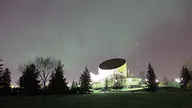The Visible Planets
Mercury is not visible in our sky from our latitude as it lingers too low along the east-northeastern horizon in the dawn’s glow to be seen easily. However, southerly latitude observers are positioned well to see Mercury in their eastern sky at dawn. This is the best morning viewing of Mercury for those in the southern hemisphere this year.
Venus is not visible this month as it is too close to the Sun to be visible.
Mars is seen low above the eastern horizon before sunrise through the month. Mars is set amongst the stars of the zodiac constellation of Pisces, the fish, through the month. Look for Mars just to the left of the waning crescent Moon on the morning of May 4 and then just to the left of the waning crescent Moon on the morning of May 5. While Mars is not that bright, it does have an unmistakable reddish colour.
Jupiter disappears into the setting Sun’s light at the start of the month and will not be seen for the rest of the month. It will be at its point of conjunction on May 18.
Saturn is found low above the east-southeastern horizon in our predawn hours through the month and is in the constellation of Aquarius, the water bearer. During the morning hours of May 3 and May 31, look for Saturn near the waning crescent Moon. Saturn and Mars will be the two visible planets in our eastern sky before sunrise through the month.
Moon Phases
May 1 Last Quarter Moon
May 7 New Moon
May 15 First Quarter Moon
May 23 Full Moon (Flower Moon or the Frog Croaking Moon)
May 30 Last Quarter Moon
Special Events
International Space Station (ISS) Observable Passes
Look for passes of the ISS in the morning predawn sky from May 1 to May 9. From May 10 to May 24, passes of the ISS can be seen throughout the night, with a few passes being visible each night. The ISS always moves in the starry sky from west to east. Exact times of these passages for your location can be found by visiting the website http://www.heavens-above.com or by using satellite tracking smart phone apps like Sputnik or Spot-the-Station.
May 3 Chang’e 6, Chinese mission to the Moon’s south pole Aitkin Basin (sample return)
May 5 Eta Aquarid meteors peak in the early morning hours.
Zenith hourly rate of approximately 50 meteors/hour.
May 13 Royal Astronomical Society of Canada (RASC) Edmonton Centre meeting
Live in the Zeidler Dome at TWOSE and presented virtually through Zoom.
7:30 p.m. – 9:30 pm
Free for anyone to attend.
See http://www.edmontonrasc.com for more details.
May 18 International Astronomy Day
Special astronomy displays and telescope observing at TWOSE.
Observatory hours this day: 1:00 pm – 5:00 pm and 7:00 pm to midnight.
May 29 Arthur Eddington tested Einstein’s General Theory of Relativity at a solar eclipse 106 years ago today.




